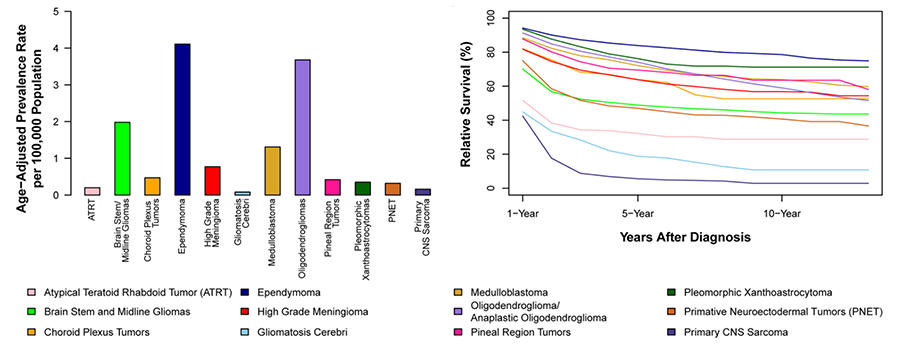How Data Provides Hope to Rare CNS Tumor Patients
, by Brittany Cordeiro, NCI-CONNECT Program Manager
Learn how a not-for-profit organization studies the incidence, prevalence, and survival of people with rare brain and other central nervous system tumors to help facilitate research and raise awareness.
People who have been diagnosed with a rare central nervous system (CNS) tumor often feel alone. In some tumor types, fewer than 40 adults are diagnosed per year in the United States. That’s why NCI-CONNECT and the Central Brain Tumor Registry of the United States (CBTRUS) partnered to study the impact of 12 selected rare CNS tumors.
CBTRUS is a not-for-profit organization that gathers and shares current epidemiological data—the study of disease burden on a population—of all primary brain and other CNS tumors. Its purpose is to facilitate research and raise awareness.
For the project with NCI-CONNECT, co-led by Mark Gilbert, M.D., and Terri Armstrong, Ph.D., of the NCI Center for Cancer Research's Neuro-Oncology Branch, they studied 12 selected rare adult primary brain and other CNS tumors, each with less than 2,000 people diagnosed per year in the United States. Their findings were published in the Journal of Neuro-Oncology and provide important disease-specific data for the design of clinical trials.
Providing statistical facts on these very rare brain and other CNS tumors gives a clear picture of the disease and helps patients and families know there are others out there affected.
Understanding the Data to Improve Care
Scientists analyzed three main epidemiologic measurements relating to population and burden of disease for the report:
- Incidence: The number of newly diagnosed cases
- Prevalence: How many people are living with the disease
- Survival: The number of patients alive for a certain period of time after their diagnosis
The incidence and prevalence data were from CBTRUS—the most in depth source of cancer registry data for brain and CNS tumors in the United States. Survival data were obtained from NCI’s Surveillance, Epidemiology, and End Results (SEER) analytic database files for cancerous brain and CNS tumors. Both data sets spanned from 2000 to 2014. All tumors included in the analysis were newly diagnosed primary cancerous tumors and didn’t include recurrent tumors or metastases.
The scientists found the overall combined incidence for all 12 tumor types is about one-and-a-half people per 100,000 people, which is extremely rare. The lowest incidence is gliomatosis cerebri with 37 adults diagnosed per year, and the highest incidence is oligodendroglioma with 1,185 people diagnosed per year. The most prevalent tumor type is ependymoma with about four people per 100,000 people. It also has the highest relative five-year survival rate of 83.9 percent. Gliosarcoma has the lowest five-year survival rate of 5.6 percent.
“In general, relative survival rates are pretty high for all 12 rare CNS tumor types. The two dominate subtypes are oligodendroglioma and ependymoma, which combined are 51 percent of the selected tumors,” says Jill Barnholtz-Sloan, Ph.D., scientific principal investigator of CBTRUS and professor at Case Western Reserve University School of Medicine in Ohio. “And since the late 1990s, there has not been a drastic change in the data. Survival has increased in some types due to advanced treatments, but for others there’s no changes at all.”
The scientists also found that the majority of these selected brain and other CNS tumors are more common in adult males age 40 and older, whites, and non-Hispanics.
“The data are very important because having accurate and up-to-date numbers on patients and knowing the expected number of patients each year by tumor type helps focus and enhance the rationale for why research and clinical trials are needed,” says Dr. Barnholtz-Sloan.
Sharing Data to Make an Impact
CBTRUS data are used by most brain tumor organizations, researchers, scientists, other health care providers, and brain tumor patients and their families. “We have created a registry model on how to collect and utilize data and are able to leverage the data in multiple ways,” says Dr. Barnholtz-Sloan.
CBTRUS provides an annual statistical report, publishes fact sheets and scientific manuscripts, and attends meeting to share its findings. Its goal is to be a resource and contribute to the global understanding of the burden of brain tumors and other CNS cancers.
“We are advocates for our work because the data are important for patients and researchers,” says Carol Kruchko, president and administrator of CBTRUS. “Working together with NCI-CONNECT is synergistic for our community. It shows how we—researchers and clinicians—are all invested in improving care for patients with these rare tumors. This provides hope to patients and their families.”
